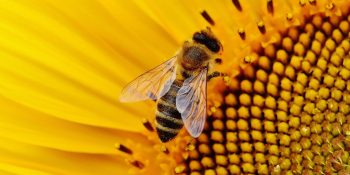The next time you snack on almonds, add blueberries to your smoothie or eat pumpkin pie, thank a pollinator and thank farmers, ranchers and private forestland owners who work hard to create and maintain their habitat.
Pollinators, such as honeybees, bumblebees, butterflies, birds, bats, flies and many others, play a critical role in crop production. Without pollinators, we wouldn’t have many crops.
During the week of June 22-28, the nation will celebrate these iconic and crucial pollinators during National Pollinator Week. This year’s theme is “Pollinators, Plants, People and Planet.” Thirteen years ago, the U.S. Senate unanimously designated the third week in June as National Pollinator Week to increase awareness about the importance of pollinators and the challenges many of them face, including serious population declines and habitat losses, often due to land use changes and excessive or improper pesticide use. Nearly 200 species of pollinators are considered threatened or extinct.
Pollination occurs when pollen grains are moved between two flowers of the same species, or within a single flower by wind or insects and animals. Successful pollination results in healthy fruit and fertile seeds, allowing the plants to reproduce.
The extensive and critical world of crop pollinators is a $20 billion a year industry. About 75 percent of crop plants are pollinated by billions of animals and insects every year
Many federal, state and local government agencies, non-government organizations and universities have launched extensive efforts to protect pollinators, especially honeybees and the Monarch butterfly. The U.S. Department of Agriculture (USDA) works closely with farmers, forest landowners and other private landowners to increase pollinator habitat in targeted areas nationwide.
The Environmental Quality Incentives Program (EQIP), through USDA’s Natural Resources Conservation Service (NRCS), offers financial incentives to agricultural producers and private forest landowners who enhance pollinator habitat by voluntarily implementing conservation practices such as cover crops, wildflower and native plantings in buffers and areas not in production.
Conservation Reserve Program (CRP) also can be used to enhance habitat to protect pollinators. Administered by USDA’s Farm Service Agency (FSA), CRP is a land conservation program in which enrolled landowners remove environmentally sensitive land from agricultural production and plant species that will improve environmental health and quality.
As owners and stewards of the land, many farmers, ranchers and private forest landowners manage their natural resources to work to achieve their production goals, they are protecting the rich and diverse ecology on or near their operations.
When we protect pollinators, we protect our ability to grow food. We thank our farmers, ranchers and private forest landowners for who offer a safe haven for pollinators and grow the products we enjoy.
Whether you are a large commodity producer, a small and diverse organic producer or even a suburban homeowner, you can have an important role in saving pollinators in Colorado.
Do your part to help protect pollinators. By taking action to diversify and beautify your operation or property, you could ensure that many fruits and vegetables are available and plentiful for future generations for many years to come.
For more information about pollinators and what you can do in Colorado, please contact your local USDA service center.
SPREAD THE NEWS
COMMENT, Like, Follow & SHARE @I70Scout
CURRENT EDITION
WEATHER & TRAFFIC PUZZLES RECENT NEWS ADVERTISE WITH US
photo credit: MGN Online

Leave a Reply